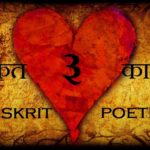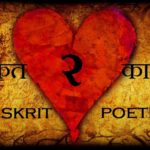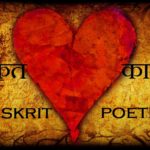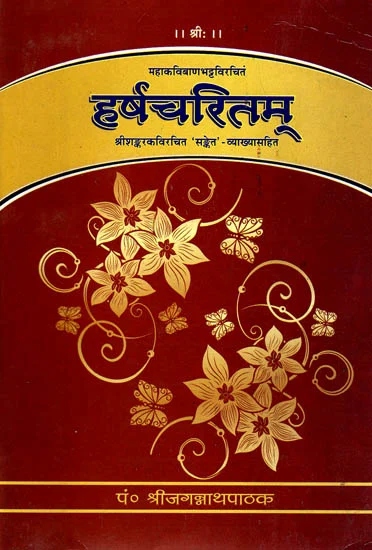
An historical romance in Aakhyaayika form, the Harsacharita was written by Banabhatta, the court Poet of Harshvardhana from Sthanesvara (also called Svathanesvara and Thanesar). It is biopic poem on the rise of the famed Emperor of North India, as well as his family. “The story in the Harshacharita is, thus not a full biography. It covers the reign of Harsha up to the recovery of his lost elder sister Rajyashri, and the royal and military activities of some years.”[1, 1]
Much like that other Akhyayika, Dasakumaracharita by Dandin, the “Harshacharitha” is a gadhya-kaavya, that is, prose-poem. It is written in prose, but refulgent in poetic sentiment.
Author
“Bana, it must be remembered, is not writing as a historian but as a poet or an epic bard, decorating his tale with fancy, fantasy, the marvel of romance and adventure, and with the literary devices of a determined poet.”[1, v]
One of the great issues in the present time is the reliance on bards by royal families to over-glorify their dynasties and even outright invent lineages. Assigning lineage by committee based on caste fraternity is no replacement for true history. As a Brahmana, Baanabhatta was entrusted with accurately recounting the historical events of his patron, court historian though he was. Though most details are accurate, his style is far too bardic. Royal dynasties must have humility and cease comparing themselves to avataras who periodically grace their lineages.
Interestingly enough, despite this being a biopic of his patron, Baana provides his own biography of sorts. In this work itself, he traces his lineage to the family of Vathsa, of Pritikuta (on the Hiranyabahu river). A member of this line was a very famous scholar honoured by the Gupta Emperors. One of his sons was the great grandfather of Baanabhatta.
Bana’s father was named Chitrabahu and his mother, Rajadevi. “The Vatsyayanas family enjoyed the favours of both Lakshmi and Sarasvati and was renowned for learning and wealth.”[1, ix]
“Bana grew up in such an intellectually and materially rich domestic atmosphere, imbibing the knowledge of all Shashtras, arts and lores.”[1, ix] He tragically lost his mother as a child, and subsequently, his father at the age of 14. Following this, Bana was bitten by wanderlust, and he began traveling with a migrant and miscellaneous band of bawds, bards, and betel-leaf carries. This “bohemian” group naturally brought out the gossip in conservative society, and Bana had quite a reputation as a result, something even he tacitly acknowledges, tongue-in-cheek.
Through the cousin of Harsha Vardhana, Bana became acquainted with and was eventually befriended by the North Indian Emperor.
“The tributes Bana has paid to old Sanskrit and Prakrit poets at the beginning of his Harshacharita show his deep acquaintance with the wide and varied range of the literature of ancient India” [1, xi]
Despite this work of historical value, Harshacharitha is not the only contribution by Banabhatta. In fact, he is of deserved celebration for the fictional novel Kadambari.
“Western scholars have compared Bana’s writing to a luxurious jungle which does not offer easy access and a passage through which is felt to be fraught with unexpected dangers in the form of recondite allusions and abstruse puns. It must however be remembered that Bana was creating a new style of prose-writing, applying all the rhetorical devices of Kavya to the writing of prose. Using oxymoron, paronomasia, alliteration and sound-effects of rhyme, poetic fancy and hyperbole, punning, use of mythology and emphasis by rhetorical exclusion, Bana was playing with language but at the same time he was widening the horizons of its meaning and its literary and cultural associations.”[1, xi]
The above passage is fulsome praise worthy of Baanbhatta himself. However, it is not entirely accurate. Gadhya-kaavya was an already extent style. Baana merely adapted it to his purposes. In the end, it is imperative to have a lived experience in a tradition to truly understand it. The proper study of poetics and its history, is therefore of import.
Composition
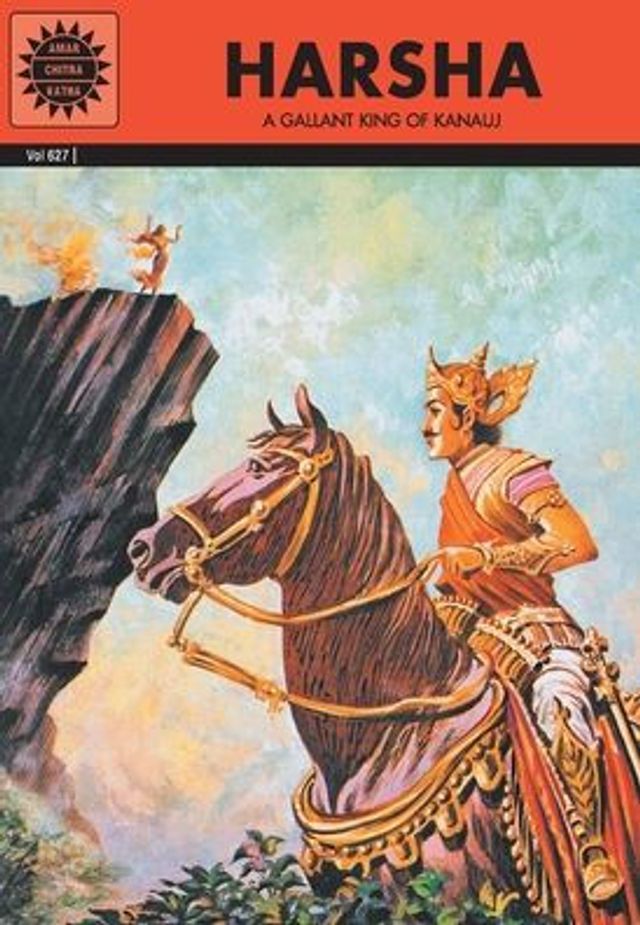
The Sanskrit word “charitha” is frequently used in the Indic tradition. Itihaasa is term suited for epic history or history analysed per dharmic implications. Charitra is the proper term for standard history. What then is charita? It is best equated to the term “chronicle” or “deeds”. The Buddhacharita is one such famed chronicle of the life of the Buddha. The Harshacharita, on the life of Harsha Shiladitya is another.
As established by Pandith Kota Venkatachalam, there were many Harshas. There was Sriharsha Vikramaadhithya of 457 BCE, who defeated the Persian invasions. Then there was the later Sriharsha of Kanaauj, who was a professional poet. But the most famous is undoubtedly the Emperor Harshavardhana Sheeladhithya, of Thanesar. He was born in the line of Pushyabhuthi and ruled in Shrikaantha land, near Delhi, around 600 CE. He was an Hindu king of ecumenical bent, who famously patronised Buddhism, and was known to the itinerant Chinese traveller Xuan Zhang. His war with Shashanka of Gauda (Bengal) and alliance with Bhaskaravarman of Kaamaroopa (Assam) are well known. Based on the Harshacharita, it is believed that he and his sister converted to Bauddha Dharma.
“The Harshcharita has eight chapters, technically called Uchchhvasas. After the customary invocation of his family and personal life and of his first interview with king Harsha, in the first two chapters.” [1, v]
Ucchvaasa means ‘a breathing out’ and also ‘a division of a narrative.”[1, 3]. The first two ucchvasas are focused on Baana and his path to meeting Harsha.
In fact, Harsha’s importance does not even feature properly until the third chapter, with his predecessor of legend, king Pushpabhuthi, ruler of Sthanesvara in what was then the land of Shrikaantha. Pushpabhuthi was a devotee of Lord Shiva and through his friendship with the Saiva muni Bhairavacharya, attained great merit and a celebrated sword Attahasa. Per the chronicle, he was blessed by the Goddess Lakshmi with a long line of great kings, Harsha being the apogee of the dynasty. [1, vi]
The Fourth Chapter focuses on Harsha’s father Prabhaakara-vardhana. “He is described as a terror to the Hunas. He vanquished the king of Sindha, Gurjaras, lords of Sindhu, Gandhara and Malava”[1, vi]
Chapter Five discusses Raajyavardhana’s victory over the Hunas, but also the return of Harsha to the capital midway, to tend to the ailing Prabhaakara. We hear of the transgressions of the king of Maalava (Malwa) against Raajyashri, and the stage being set for the conflict of Harsha’s lifetime, following his rise to power.
Chapter Six provides an overview of the exact circumstances in which Harsha is forced to take the throne . Chapter Seven covers diplomatic relations between Svanthanesvara and Praagjyotisha (Assam), and how they forge an alliance to take on Maalava and Gauda. The Final Chapter covers the search for Raajyashri.
“The last chapter narrates Harsha’s meeting with Rajyashri through an ascetic Divakaramitra, a friend of Grahavarman, who had now embraced Buddhist religion. Rajyashri was saved by the two from immolating herself. She had suffered very much and wish to have red robes. Harsha persuaded her to wait till he had fulfilled his vow of destroying the Gauda king, and promised that he himself would assume red robes with her— a hint of Harsha’s conversion to Buddhism.” [1, vii]
Is the Harshacharita a work of history?—the answer is partially. Is the Harshacharita of historical value?—the answer is yes. It is not a proper work of history as by almost the virtual admission of the author himself, the focus is on poetry. This is not merely due to the poetic form, but due to Baana’s own inclination to merely utilise Harsha’s biography as a pretext to display his poetic skill. It is more a Ballad than true chronicle, despite the name.
Nevertheless, like Le Chanson de Roland and El Cantar de Mio Cid, there is historical value for historical insight. There is clear accounting of lineage and relevant biographic detail, description of various conflicts and achievements, and critical points relating to Harsha’s rise to power in the dynasty of Pushpabhuthi. Harsha’s sister was married to Grahavarman of the Maukhari dynasty, in Kanyakubja (Kannauj). [1, vi] Harsha’s great enemies the King of Malwa and Sasanka of Gauda are mentioned. Interestingly enough, Ucchvaasa 7 provides us with a brief history of Ancient Indian Royal Intrigue. Vasudeva Kanva, Shudraka, and even Chandra Gupta II Vikramaditya are all mentioned, as well as their various strategems and escapades. Of particular interest was the episode of the brahmin Pushyamitra Sunga’s betrayal of the Maurya emperor Brhadratha. Also noted was how the last Sunga king (Devabhuthi) was “over-libidinous” and raped his minister’s daughter-in-law, leading to the Sunga demise and the rise of the brahmin Kanva dynasty.
Court Poets are wont to wax eloquent over their masters, but it’s clear Baana crosses over to the other side. Some western scholars have minimised this even more so, calling it outright “historical romantic fiction” [1, v], but this is goes too far. While there are hyperbolic aspects and experiences with the Divine, this is not uncommon even in sources of history for Medieval Europe…
If Geoffrey of Monmouth’s History of the Kings of Britain can begin with the near mythological Tale of Trojan exiles landing in the British Isles, there is no reason similar aspects relating to the meta-normal, can’t be put aside while accepting cold hard facts such as the fall of Raajya-vardhana to an assassin’s arrow or his victory over the Huns. When the Garga-samhita and fraudulent Yuga Purana can be used by western scholars for historical purposes, there is no reason the Harshacharita cannot be. Is it proper history?—no. Is it a historical hagiography?—yes. When modern court poets-cum-cricket commentators such as Ramachandra Guha can be taken seriously, there is no reason actual court poets can’t be
Even the translators are forced to admit the following:
“The Canons of Sanskrit criticism describe this tale as an akhyayika, that is, an historical tale rooted in authentic tradition. The outlines, as we have seen, are factually correct. Yet the Harshacharita must be regarded as an epic in prose, in the romantic tradition of wandering minstrels and bards.”[1, viii]
“The Harshacharita is written in a style that is mellifluent, profound and of elaborate workmanship. It is quite a contrast to the simply and plain style of the Panchatantra. The descriptions are graphic picturesque and greatly varied in style and content.” [1, viii]
Literary baroque may appeal to some sahrdayas (or lay enthusiasts), but it does not to this critic. Despite an excellent work in the form of the Kadambari, Bana lets us down here.
Athisayokthi has its limits, and while bards and minstrels are paid to praise their kings, historians—even court historians—must have some limits to hyperbole. Exaggerated comparisons lead to hubris among already arrogant royals. All must be humble before avataras, who are not mere “ancestors” of kings, but the Divine human form. The style of hyperbolic poetry is often traced to Gauda—a fact mentioned by Baana himself.
Selections

“7.In the North plays on words are mainly admired, in the West it is only the essence; in the South it is poetical fancy, in Gauda pomp of syllables” PM.s,7[1, 2]
§
“13. Satavahana made an immortal refined treasure of song, adorned with fine expressions of purest character like jewels.”[1, 3]
§
“15.Bhasa gained as much splendour by his plays with introductions spoken by the manager, full of various characters, and furnished with startling episodes, as he would have done by the erection of temples, created by architects, adorned with several stories, and decorated with banners.” [1,4]
§
“16.By whom is not delight felt at the beautiful expressions uttered by Kaalidaasa as at sprays of flowers wet with honey sweetness?”[1, 4]
§
“20. A narrative, like a bed, which is to wake up its occupant happily refreshed, is set off by its well-chosen words like feet, luminous with the clever joining of harmonious letters.” [1,5]
§
“1.Victorious is Harsa who guards the world by a wall of fire of glorious majesty, —
A mountain of good fortune for fulfilling the desires of all his friends’” [1, 5]
§
Description of Sarasvati
“She might be described as the moon’s family goddess, the simple which could restore to life the god of the flowery bow, the shore of love’s ocean, the effulgence of youth’s moonrise, the great river of passion’s ambrosia, the efflorescence of dalliance’s tree, the primer of archness, the moonlight of beauty, the strength of steadfastness, the sanctum of reverence, the nursery garden of bienseance, the conference of excellencies, the wisdom of magnanimity, the satiety of youthfulness.” [1, 35]
§
On Bhairavaacaarya
“dwelling of dharma, teertha of truth, storehouse of sincerity, burgh of purity, hall of high character, domain of patience, rice-plot of unassumingness, pedestal of constancy, support of steadfastness, mine of mercy, home of happiness, pleasance of pleasure, palace of propitiousness, mansion of venerableness, congress of refinement, genesis of good feeling, end of evil: such was the holy Bhairavaacaarya, a very Siva incarnate” [1, 113]
§
On Prabhakara-vardhana
“The line so proceeding, there was born in course of time a king of kings named Prabhaakaravardhana, famed far and wide under a second name Prataapaceela, a lion to the huna deer, burning fever to the king of the Indus land, a troubler of the sleep of Gujarat, a bilious plague to that scent-elephant the lord of Gaandhaara, a looter to the lawlessness of the Laats, an axe to the creeper of Maalwa’s glory.” [1, 130]
§
On Yasovati
“She was honey in converse, ambrosia to those who sought delight, rain to her servants, beatitude to her friends, bamboo-like to her elders. The pride was she of the family of smiles, the penance purity of womanhood, the fulfillment of Kaama’s ordinances, the Eureka [Vyutthaanabuddhir; thought of a yogi’s meditation]of loveliness the ovation of passion, the fruition of beauty’s wishes, the special providence of charm, the genesis of affection’s ancestry, love’s boon-winning, grace’s perfect creation, youth’s majesty, intelligence’s cloudless rain, glory’s lustration, goodness’ bloom of beauty, Dharma’s heart’s delight, Prajapati’s creation of the atoms of bliss; the quietude of quiescence” [1, 133]
§
Six great jewels are mentioned in couplet
“manyacakaricakraani varaa stree parinaayakah
Sad etaani tu ratnaani kirtitaani maneesibhih” [1, 141]
§
On Harsha
“His natural instinct is to help his friends, sovereignty means to him helping his dependents, learning at once suggests helping the learned and success helping his kinsfolk, power means helping the unfortunate and wealth helping the braahmans; his heart’s main occupation is to remember benefits, and his life’s sole employment is to assist virtue, his body’s one use is to carry out the dictates of courage, and the earth’s to be an arena for his sword, attendant kings are wanted to amuse him, and enemies to help his majesty to shew itself. It could have been by no common, merits in former births that he attained this glorious preeminence so that the shadow of his feet diffuses an all-excelling ambrosia of happiness around him.”[1, 57]
§
“he next beheld a stable of the king’s favourite horses from Vanaayu, Aaratta, Kamboja, Bharadvaaja, Sindh, and Persia, —red, dark, white, bay, chestnut, dappled like partridges, marked with the five auspicious kind of marks”[1, 65]
§
“There are women like elephants in gait, yet noble-minded; virgins, yet attached to worldly pomp; dark, yet possessed of rubies; their faces are brilliant with white teeth, yet is their breath perfumed with the fragrance of wine; their bodies are like crystal, yet their limbs are soft as acacia flowers; they are unattainable by paramours, yet robed in bodices; wide are their beautiful hips, yet are they possessed of thin waists; lovely are they, yet honeyed in speech; they trip not, yet have a bright and captivating beauty; they are without curiosity, yet wedded.” [1, 105] This selection is full of puns, i..e. curiosity puns as marriage thread.”
§
Conclusion

The Harshacharita is one of those rare great works that come as a disappointment. While praise has typically been lavished here on the works of our great Classical past, the civilization of Truth must also adhere to it.
Truth be told, Banabhatta’s Harshacharita is the embodiment of precisely why nara-sthuthi is viewed with disdain among learned Braahmanas, and there are several passages worthy of ninda. The very definition of saccharine, the incredulous encomiums exceeding praise to the very Gods (even diminishing them before the pedestal of a mortal) make this poet’s work an example of why learning in Sanskrit must be used responsibly.
The author has managed to not only turn off the student of history, with excessive focus on ornateness of lyric, but also the student of poetry, by taking even atisayokti to exaggerative limits. This is not to say that neither the subject matter nor the poet are wanting greatness—but that Banabhatta’s sense of the poetic here is lacking in taste. He would have been well-advised to take to heart the advice of Mahakavi Bhavabhuti, and realise that a poet has a duty to credulity and restraint.
Indeed, Harshacharita is plainly the weaker of Banabhatta’s 2 credited works. Through the Harshacharita, this Bhargava of the pen has proven the old adage that Less is More…truly.
It is of course rare for us to criticise a kavi like Baana so. But it is equally important that posterity understand what is good poetry and what isn’t. Baana’s imagination is certainly splendid, but ornateness and credulity have their limits. He frequently distinguishes himself in his knowledge of Itihaasa-Puraana, and even in his poetic description of some sections. However, his praise of Harsha is beyond fulsome. With such court poets, it is easy to see why many of those descended from kings of old are supercilious to the point of extreme stupidity.
Harsha himself after all, was no master of the Five Indies, having been famously defeated by Chalukya Pulakeshin II at the Battle of the Narmada. North Indian Emperor, though he was, Harsha’s grandeur did not exceed Gods. Good poets of the future should recognise this, and compose accordingly. There is praise, and there is unseemly praise. The Harshacharita helps us understand this.
Nevertheless, it is work that is not wholly without poetic merit, let alone historical merit. As the description of Sarasvati above shows, Baana is a talented wordsmith when at his restrained best. Perhaps in writing about his patron, he just got carried away. In any event, it is certainly a work of historical value, of benefit to posterity, and grants us a vision of what the Vardhana era was like, and why Harsha was indeed, so heavily hailed.
References:
- Cowell, E.P. and P.W. Thomas, Ed. R.P.Shastri. The Harsacharita by Banabhatta. Delhi: Global Vision Publishing House. 2005
